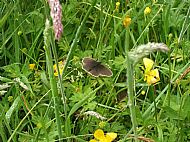Coppicing
Description and Historical Usage in Scotland
Coppicing is one of the oldest forms of sustainable woodland management known in Britain. It mimics the effects of animal browsing of native broadleaves that will regenerate from a stump or 'stool'. The woodland is divided into 'cants' or 'coupes' which are cut in rotation and then left to regrow. The frequency of the cutting rotation depends on the tree species, growth rate and desired product.
The practice of leaving some trees to grow on in a coup is called 'Coppice and Standard Management'. Trees ranging from saplings to mature specimens are left uncoppiced to produce a sustainable source of large diameter timber.
There is a long history of coppicing in Scotland from archaeological evidence of coppiced hazel as an Iron Age building material to the more intensively coppiced oaks of the west coast which were converted to charcoal for the Iron smelting industry in the 17th and 18th Centuries.
Coppicing at Stoneheap Wood
At Stoneheap Wood the coppiced wood is mainly being used as woodfuel. Other uses thus far have also included tool handles and walking sticks. It is hoped that the larger timber left will be of more value in future years at local timber mills.



Stoneheap wood is dominated by Sitka Spruce, Alder and Sycamore. The Sitka is now getting to a size where it is shading out some of the more desirable species such as Oak. A quarter of the Alder is dead from phytopthera and the rest is in various stages of decline. The coppicing process allows us to remove the Sitka and dead Alder to replant with a wider range of predominantly native species for the site.
Biodiversity and Coppicing
As each coup is felled and allowed to regrow the ground vegetation has a period of increased growth peaking in years 4-6. After this the canopy starts to close over and the vegetation is shaded out.

With each growth flush a higher number of invetebrates, birds and small mammals are supported. They seem to migrate in rythym around the wood following the coppice cycle.
In Stoneheap Wood the Wren, although already present, has increased in numbers within the enclosed coupes, 9 recorded sitting together on top of a deadhedge!
Biodiversity of coppice woodland is well documented in 'Coppiced Woodlands: their management for wildlife' Fuller & Warren 1993 JNCC.

